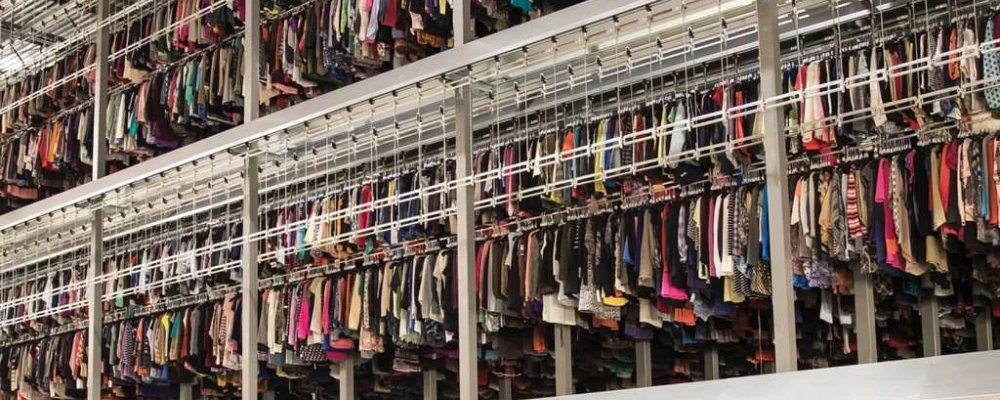
What Does the Future Hold for Fast Fashion?
The fashion industry is massively polluting – thanks to the big profit-driven and lazy habits our largest fashion retailers have fallen into. The industry contributes around 1.2 billion tonnes of carbon emissions to the planet’s atmosphere every year – it’s the second largest polluter after the oil industry. Yet the cheap clothes it makes available to the mass market, ensures its unfortunate enduring popularity.
In the past year, we’ve seen several reports stating that although efforts to make fashion more sustainable are becoming more widespread, the market for Fast Fashion is booming.
In this blog series, I’ve been exploring the current state of Fast Fashion, where it sits within the fashion industry today, its perception among consumers and, of course, its impact on the environment. For my final post in the series, I want to look at the direction Fast Fashion is headed in. Will the likes of Primark, H&M and Boohoo.com maintain their popularity for quick fashion fixes? Will we see a decline in sales of clothing all round? Or will people continue to spend and acquire clothing, but in more ethical and sustainable ways?
What's the current state of the Fast Fashion industry?
There have been a number of surveys recently reporting a general preference towards sustainable and ethical products among consumers. In 2019, Hotwire reported that 47% of global internet users said they switched to a different product or service because a company had ‘violated their personal values’. The value that topped the list? Climate change.
And yet these values don’t seem to be translating into figures, when it comes to the sales reports of Fast Fashion’s biggest names.
The notorious Boohoo.com, which sells its own brand clothing in one of the most aggressive Fast Fashion business models today, reported record-breaking sales in the last quarter of 2019. Following the crucial festive period, it was Boohoo.com that rose to the top of the retail charts with a share value of £3.9 billion, rising 5% and beating British high street stalwart Marks and Spencer who came in at £3.7 million who meanwhile reported slumps over Christmas.
Boohoo’s popularity among millennials and Gen-Z shoppers, its global reach and strengths in collaborations with celebrity endorsers are touted as the reasons behind such fast growth.
Its future profit status is said to be questionable though. We are slowly seeing more industry restrictions come into place on materials, carbon emissions and supply chains that are reflective of a drive towards sustainability and ethical practice. This will of course impact Boohoo, whose cheap prices (and market appeal) are dependent on squeezing costs in every area.
The question of affordability
The biggest barrier to making truly sustainable fashion more mainstream, is the cost to the consumer. Fast Fashion retailers are able to sell at their famously low prices because they don’t pay fair wages, they source materials cheaply and they buy and sell in bulk.
Sustainable and ethical brands just can’t compete because under fair and environmentally safe conditions, bikinis just don’t cost £1 to design, manufacture and market.
Some are saying that as more consumers are educated into understanding the benefits of sustainable fashion, prices of products will drop as demand increases. A similar phenomenon has already been observed in the market for organic food.
One of the areas where consumers are most likely to be persuaded to buy sustainable fashion is in durability. ‘Investment piece’ has long been the favourite phrase of fashion editors persuading readers to spend big on designer goods, but this is increasingly heard among sustainable brands encouraging their customers to buy for the long-haul. This is often a direct retort to the poor quality goods churned out by Fast Fashion businesses.
How are shopping habits changing?
The clues to how Fast Fashion will continue to perform in the next decades are held in the shifts we are seeing currently in how people are shopping and interacting with fashion brands generally.
- Shift to online - retailers who have a purely online offering don’t need to maintain their presence on the high street, where high street retailers struggle to attract the markets who are shopping online only
- Community building – whether in physical stores and through shopper events, or online on social media means that consumers are having more conversations with each other and brand reps. This opens up the potential for brands to communicate their core values direct to their customers – and receive feedback in return
- Rental services are on the rise – the most well-known service, Rent the Runway, was valued at $1 billion in 2019. These services allow consumers to access luxury brands at affordable prices, increasing each piece’s price-per-wear value and decreasing clothing waste.
- Millenials hold the purchasing power – the rise in this consumer market has seen Fast Fashion players make a grab for the ‘quick win’ purchase popular among a generation who have been left unable to afford to buy a house or start a family. However, this is also a group with greater access to information than ever before, who are enlightened about climate change and social causes.
To join in the conversation about sustainable fashion with like-minded, creative entrepreneurs, follow us on Facebook and Instagram or sign up to become a Member of The Sustainable Fashion Collective
